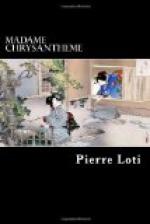* * * * *
I must admit that this episode of my childhood and the spiders, have little to do with the story of Chrysantheme. But an incongruous interruption is quite in keeping with the taste of this country; everywhere it is practiced, in conversation, in music, even in painting; a landscape painter, for instance, when he has finished a picture of mountains and crags, will not hesitate to draw in the very middle of the sky a circle, or a lozenge, or some kind of framework, within which he will represent anything incoherent and inappropriate: a bonze fanning himself, or a lady taking a cup of tea. Nothing is more thoroughly Japanese than such digressions made without the slightest apropos.
Moreover, if I roused my past memories, it was the better to force myself to notice the difference between that 14th of July last year, so peacefully spent amidst surroundings familiar to me from my earliest infancy, and the present animated one, passed in the midst of such a novel world.
To-day, therefore, under the scorching mid-day sun, at two o’clock, three quick-footed djins dragged us at full speed,—Yves, Chrysantheme and myself,—in Indian file, each in a little jolting cart, to the further end of Nagasaki, and there deposited us at the foot of some gigantic steps that run straight up into the mountain.
These are the granite steps leading to the great temple of Osueva; wide enough to give access to a whole regiment; they are as grand and imposing as any work of Babylon or Nineveh, and in complete contrast with all the finical surroundings.
We climb up and up,—Chrysantheme listlessly, affecting fatigue, under her paper parasol painted with pink butterflies on a black ground. As we ascended, we passed under enormous monastic porticos, also in granite of rude and primitive style. In truth, these steps and these temple porticos are the only imposing works that this people has created, and they astonish, for they scarcely seem Japanese.
We climb up still higher. At this sultry hour of the day, from top to bottom of the immense gray steps, only we three are to be seen; on all that granite there are but the pink butterflies on Chrysantheme’s parasol, to throw a cheerful and brilliant note.
We passed through the first temple yard, in which are a couple of white china turrets, bronze lanterns, and the statue of a large horse in jade. Then without pausing at the sanctuary, we turned to the left, and entered a shady garden, which formed a terrace halfway up the hill, and at the extremity of which was situated the Donko-Tchaya,—in English: the tea-house of the Toads.
It was here that Chrysantheme was taking us. We sat down at a table, under a black linen tent, decorated with large white letters (of funereal aspect), and two laughing mousmes hurried up to wait upon us.
The word mousme means a young girl, or very young woman. It is one of the prettiest words in the Niponese language; it seems almost as if there were a little moue[C] in the very sound, and as if a pretty taking little pout such as they put on, and also a little pert physiognomy, were described by it. I shall often make use of it, knowing none other in our own language that conveys the same meaning.




